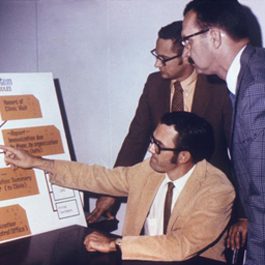The United States Department of Health and Human Services and the Centers for Disease Control and Prevention offer Child and Adolescent Immunization Schedules for children aged 0-6 years and 7-18 years, as well as a “catch-up schedule” for kids four months to 18 years old who may have missed recommended vaccinations. All of these schedules are approved by the Advisory Committee on Immunization Practices (ACIP), the American Academy of Pediatrics (AAP), and the American Academy of Family Physicians (AAFP).
Some vaccinations have been recommended in the United States since the 1940s, although the official annual schedule endorsed by ACIP, AAP, and AAFP did not appear until 1995. A combined vaccine for diphtheria, tetanus, and pertussis (whooping cough) was recommended in the 1940s; a combined vaccine for those three diseases is still recommended today. The smallpox vaccine, on the other hand, was on the schedule in the 1940s but is no longer recommended, as smallpox was declared eradicated in 1980 and eliminated from the United States much earlier.
The newly developed vaccine for polio was recommended in the 1950s. The specific vaccine used has changed since then, but polio vaccine remains on the current schedule. The combined measles, mumps, and rubella vaccine was added to the list of recommendations in the 1970s, after vaccines for all three diseases were developed in the 1960s.
The resulting recommended vaccination list included vaccines for seven diseases in the 1970s:
Tetanus
Diphtheria
Pertussis (whooping cough)
Polio
Measles
Mumps
Rubella
Protection for the remaining seven diseases on the schedule, however, required only three vaccinations:
Polio vaccination
Combined vaccination for Tetanus, Diphtheria, and Pertussis (DTP vaccine)
Combined vaccination for Measles, Mumps, and Rubella (MMR vaccine).
The list of recommended vaccines continued to be updated as vaccines were developed for more diseases. The Hib (Haemophilus influenzae type b) vaccine was added to the list in the late 1980s, while a vaccine for hepatitis B was added in the mid-1990s. In 1995, the ACIP, AAP, and AAFP began issuing annual updates to the schedule. The annual updates contained detailed information about the recommended vaccines, including specific age- and dosage-related information, as well as information about new vaccines as they were added to the schedule. Since then, a number of vaccines have been added, including those for chickenpox (varicella) and hepatitis A, while others have been removed or replaced. (The first rotavirus vaccine added to the schedule was removed because of an association between the vaccine and intussusception, a type of bowel obstruction. It was later replaced with a different rotavirus vaccine that has no association with the condition.)
As of early 2014, the U.S. immunization schedule for children ages 0-6 years includes recommendations for the following vaccinations:
Hepatitis B
Rotavirus
Diphtheria, Tetanus, and Pertussis (combined DTaP vaccine)
Hib (Haemophilus influenzae type b)
Pneumococcal
Polio (inactivated vaccine)
Influenza
Measles, Mumps, and Rubella (combined MMR vaccine)
Varicella (chickenpox)
Hepatitis A
Meningococcal (certain high-risk groups only)
In addition, the 7-18 years schedule recommends human papillomavirus (HPV) vaccination and meningococcal vaccination.
These schedules are reviewed annually; new vaccines are considered for addition to the schedule after licensure, though not all licensed vaccines are added to the schedule. (The yellow fever vaccine, for example, is unlikely to be added to the schedule, as only individuals traveling to yellow fever endemic areas need to be vaccinated against it.)
Source: The History of Vaccines















